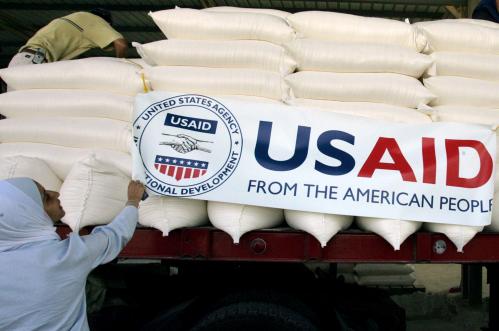To understand what the Trump Administration’s new National Security Strategy (NSS) holds for development, a comparison with past strategies is instructive.
Every administration since President Reagan in 1987 issued at least one NSS, following a requirement put into law as part of the Goldwater-Nichols Act in 1986.
As global and U.S. priorities are far different today than during the Cold War and the immediate period thereafter, especially with the 9/11 attack sixteen years ago, it is most relevant to look at the National Security Strategies from 2002 onward.
President Bush
President George W. Bush issued two national security strategies, in 2002 and 2006. President Obama issued two—in 2010 and 2015.
The Obama strategies set forth broad goals, while the Bush strategies were more “how-to.” Both were aspirational and internationalist in tone. They set reducing global poverty as a moral and strategic imperative and linked U.S. interests to the economic and political progress in developing countries. Among the objectives cited in those NSSs were to avoid pandemics, enhance regional stability, and create markets for American products and investment.
The Bush strategies set out a “path forward”—specific targets and a reform agenda, including doubling the world’s poorest economies, increasing foreign assistance by 50 percent, enhancing results through better measurement and evaluation, and improving public health (including by tackling HIV/AIDS and malaria), boosting education, and supporting agriculture. The strategy linked foreign assistance to promoting freedom and democracy, and called for respecting human dignity, rule of law, and women’s empowerment.
President obama
The Obama strategies set more general goals. The 2010 NSS called for increasing foreign assistance to help the world’s poorest countries and investing in long-term development and in global public goods, including global warming, epidemic disease, and food security. It noted the inter-linkage of democracy, human rights, and development in new and fragile states and acknowledged the legitimacy of peaceful democratic movements and the rights of women and girls. It recognized freedom from want as a basic need and recommended a global health strategy and addressing food security and humanitarian crises.
The 2015 strategy called for ending extreme poverty within a generation, and linked that to shared prosperity. The Ebola outbreak in West Africa informed the call for a global system to prevent avoidable epidemics and report outbreaks. American values were identified as a source of strength and security.
president trump
The Trump NSS, in keeping with his ‘America First’ agenda, is less aspirational, and less specific. The 2017 NSS notes the success of the Marshall Plan and assistance for the transition of Central and Eastern Europe, using those as examples of assistance reaching an endpoint. It highlights Russia and China as competitors for influence in the developing world.
Foreign assistance and development appear under the strategy’s fourth strategic pillar, which is to ‘Advance American Influence.’ To encourage aspiring partners, the 2017 NSS calls for shifting from grant assistance to approaches that crowd-in private capital. The new strategy prioritizes modernizing U.S. development finance tools, capitalizing on new technologies, incentivizing reform, and strengthening fragile states where failure would magnify threats to the American homeland.
To advance American values, the 2017 NSS prioritizes support for individual human dignity, the defeat of transnational terrorist organizations, the empowerment of women and youth, the protection of religious freedom, and the reduction of human suffering (including food security and health).
Distinctions
In comparing the Trump approach with his predecessors,’ a key distinction is the current focus on America First and the lack of emphasis on the U.S. being part of the global community. The 2017 NSS is not as targeted as the Bush strategy nor as aspirational as either Bush or Obama’s. Those strategies raise the reduction of global poverty as imperative for moral reasons and for our own self-interest. Obama went even further, calling for the end of poverty.
The Trump strategy does not raise development and poverty alleviation to the level of a core principle and objective. Whereas Obama’s second NSS endorsed the Millennium Development Goals, Trump has no reference to the successor Sustainable Development Goals.
On one level, the NSS 2017 cites nothing new pertaining to development. The push to enhance U.S. development finance tools is welcomed but has been around for a decade. Both the Bush and Obama administrations incorporated new technologies to achieve development solutions. The conundrum of fragile states has been receiving heightened attention the past decade, and seeing it highlighted in the Trump NSS is salutary.
What is different is the tone and the approach, and here the context of how each strategy deals with development is revealing:
- The Bush strategies place the discussion of development issues under the rubrics of “Championing Aspirations for Human Dignity” and “Expand the Circle of Development by Opening Societies and Building the Infrastructure of Democracy”.
- Obama’s strategies place most of the discussion of development under the broad categories of prosperity and values. Under those are the specific rubrics of “Accelerate Sustainable Development,” “Promote Democracy and Human Rights Abroad,” “Promote Dignity by Meeting Basic Needs,” “End Extreme Poverty,” “Empower Civil Society and Young Leaders,” “Advance Equality.” In addition, under security is “Confront Climate Change” and “Increase Global Health Security.”
- In contrast, the relevant provisions in Trump’s NSS fall under “Advance American Influence,” with specific subheadings of “Encourage Aspiring Partners,” “Achieve Better Outcomes in Multilateral Forums,” and “Champion American Values.”
The Bush and Obama strategies positioned the U.S. role in development as part of a global effort that tied our country’s national interest with progress elsewhere in the world, even where there is no overt linkage. As an example of the more U.S.-centric Trump NSS, it prioritizes fragile states only “where state weakness or failure would magnify threats to the American homeland.” This is much narrower than the mainstream concept of recent administrations that fragility endangers U.S. interests where it would threaten regional stability and development prospects of friendly countries. Glaringly absent is any reference to the promotion of democracy or addressing the global refugee crisis.
While the specifics on development are mostly mainstream and constructive, the absence of a more holistic view of the U.S. with a future tied to the prosperity and security of the rest of the world is disturbing.







Commentary
Development as a featured theme in US National Security Strategies since 2002
December 22, 2017